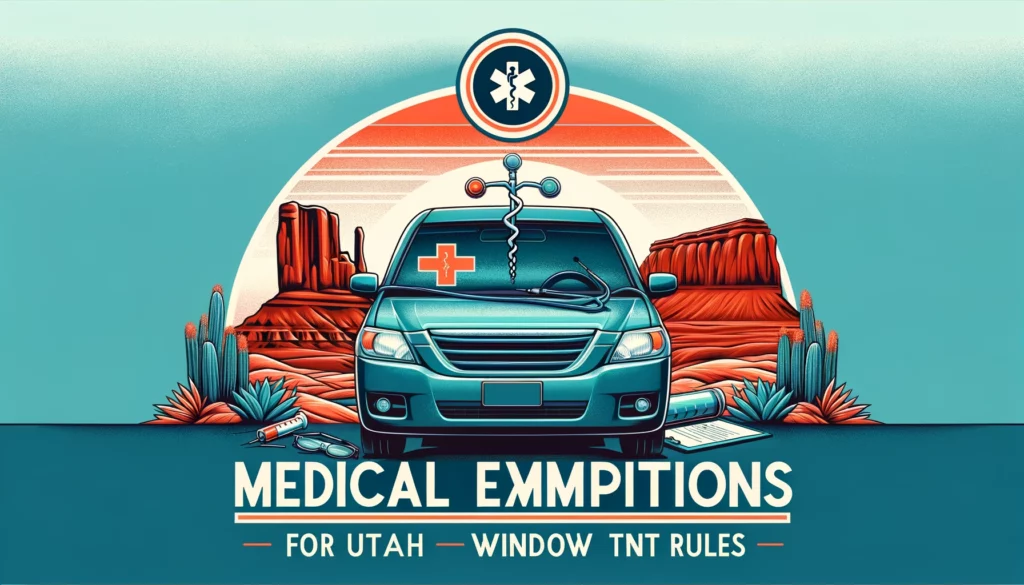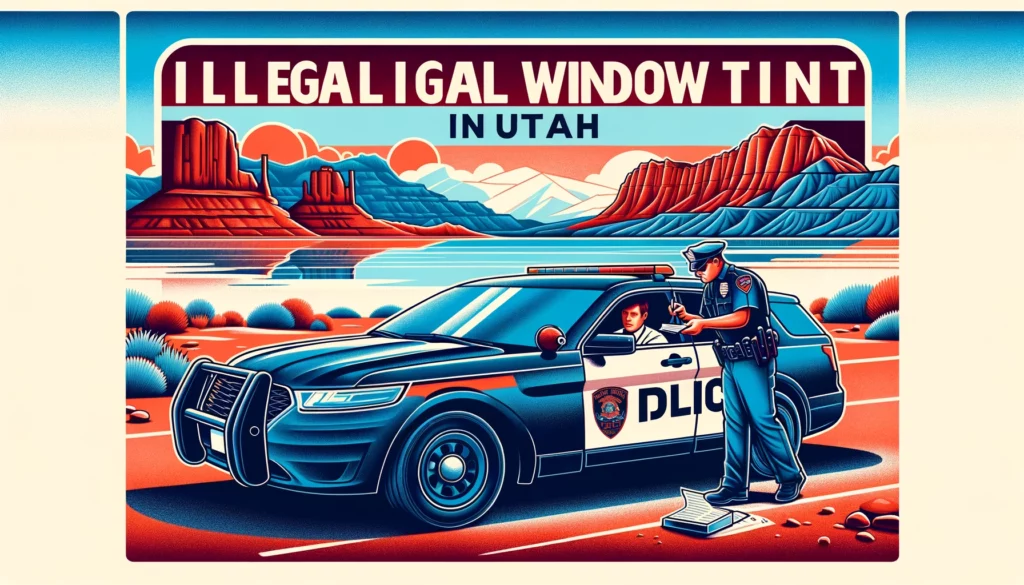Darkest legal tint for Sedans in Utah
- Windshield: Non-reflective tint allowed above the manufacturer’s AS-1 line (typically the top 4 inches).
- Front Side windows: Must allow more than 43% of light in.
- Back Side windows: Must allow more than 28% of light in.
- Rear window: Must allow more than 28% of light in.
Darkest legal tint for SUV and Vans in Utah
- Windshield: Non-reflective tint allowed above the manufacturer’s AS-1 line, typically the top 4 inches.
- Front Side windows: Must allow more than 43% of light in.
- Back Side windows: Must allow more than 28% of light in.
- Rear window: Must allow more than 28% of light in.
Utah Tinting Regulations
Before we delve into the nitty-gritty, it’s essential to understand why such regulations exist:
- Safety: Overly dark windows can hinder a driver’s visibility, especially during nighttime, increasing the risk of accidents.
- Law Enforcement: For officers, being able to see inside a vehicle, especially during traffic stops, is crucial for their safety.
Reflecting on Tint Reflection
While some tints can give your car that cool mirrored effect, Utah has specific regulations about this:
- For Both Sedans and SUVs/Vans:
- Front & Back Side Windows: No mirrored or metallic appearance is allowed.
Other Key Regulations to Note
- Side Mirrors: If you’ve tinted any window behind the driver, you’ll need dual side mirrors.
- Restricted Colors: Good news! Utah doesn’t put any restrictions on tint colors.
- Tint Variance: There’s a leeway of 5% when it comes to the VLT.
- Certificates: While some states require film manufacturers to certify their products, Utah isn’t one of them.
- Stickers: You won’t need a sticker to identify legal tinting in Utah.
- Medical Exceptions: Some states allow darker tints for medical reasons, but Utah isn’t on that list.
- Penalties: If you’re caught with illegal tint, it’s classified as a traffic infraction.
Medical Exemptions for Utah Tint Laws

The burning question: Does Utah allow medical exemptions for window tinting?
- No Medical Exemptions: As of the latest regulations, Utah does not provide medical exemptions that would allow individuals to have window tints darker than the standard regulations. This means that regardless of one’s medical condition, the same window tinting rules apply to all.
Why Doesn’t Utah Allow Medical Exemptions?
While the specific reasons aren’t always detailed in the law, potential reasons might include:
- Safety Concerns: Darker tints can reduce visibility, especially during nighttime, which can be a safety hazard on the roads.
- Enforcement Challenges: Allowing medical exemptions could make it difficult for law enforcement officers to determine which vehicles are compliant and which aren’t without checking medical documentation.
Alternatives to Consider
If you have a medical condition that requires reduced exposure to sunlight, here are some alternatives to consider:
- UV Blocking Clear Films: These films can block out harmful UV rays without darkening the windows, offering a potential solution for those with sun-sensitive conditions.
- Protective Clothing: Consider wearing UV-protective clothing, wide-brimmed hats, and sunglasses when driving to reduce sun exposure.
- Plan Your Travel: If possible, try to drive during times when the sun’s intensity is lower, such as early mornings or late afternoons.
Window Film Certificates and Stickers In Utah
In many states, film manufacturers need to certify the window film they sell. But what about Utah?
- Certification Not Mandatory: Interestingly, Utah stands out here. The state does not require film manufacturers to certify the window film they sell. This offers flexibility to manufacturers but also places the onus on vehicle owners to ensure their tint complies with state regulations.
Stickers: Utah’s Approach
Stickers can often serve as a quick reference for law enforcement to verify the legality of a vehicle’s window tint. So, how does Utah handle this?
- No Sticker Requirement: In Utah, you won’t need a sticker to identify legal tinting on your vehicle. While this means less hassle for car owners, it also emphasizes the importance of ensuring your tint meets the state’s VLT (Visible Light Transmission) requirements.
Ensuring Compliance
Given the absence of mandatory certificates and stickers, how can you ensure your vehicle’s tint is compliant?
- Know the VLT Limits: Familiarize yourself with Utah’s VLT requirements. For instance, front side windows must allow over 35% of light in, and there’s flexibility with the darkness for back side and rear windows.
- Choose Reputable Installers: Opt for well-reviewed and reputable window tint installers. They’ll likely be well-versed in state regulations and use compliant products.
- Self-Check: Consider getting a VLT meter or seeking services that offer VLT checks. This can give you peace of mind, knowing your tint is within legal limits.
Penalties or Ticket Cost for Illegal Window Tint in Utah

In Utah, if your window tint doesn’t meet the state’s regulations, you could be looking at a few different costs:
- Base Fine: The exact amount can vary, but typically, the fine for non-compliant window tint in Utah can range up to $50 for a first offense. Repeat offenses might see this amount increase.
- Court Costs: On top of the base fine, you might also be on the hook for court costs, which can vary depending on the jurisdiction.
- Removal Costs: If your tint is found to be illegal, you’ll likely need to have it removed, which can be an additional expense, especially if done professionally.
Avoiding the Fine
The best way to avoid a ticket for illegal window tint in Utah is simple: ensure your tint is compliant. Here are some tips:
- Know the Limits: In Utah, front side windows must allow over 35% of light in. There’s more flexibility for back side and rear windows, but it’s essential to be aware of the specifics.
- Ask for Certification: Even though Utah doesn’t require film manufacturers to certify their products, it’s still a good idea to ask your installer about the film’s specifications to ensure it meets state regulations.
- Consider a VLT Check: Some services offer Visible Light Transmission checks, which can give you peace of mind that your tint is within legal limits.
Conclusion
Window tinting can offer numerous benefits, from protecting against UV rays to enhancing privacy. However, it’s crucial to ensure that your tint meets Utah’s regulations. Whether you’re a resident or just passing through, adhering to these laws will ensure a smoother ride, free from the worries of potential fines or the hassle of removing non-compliant tint. So, the next time you’re taking in the beauty of Utah’s landscapes from your car, you can do so with the peace of mind that you’re in full compliance with the state’s window tinting laws.
State of Utah Info
Utah! A state that seamlessly blends the urban sophistication of its cities with the raw, untouched beauty of its landscapes. From the snow-capped peaks of the Wasatch Range to the mesmerizing red rock formations of its national parks, Utah is a treasure trove of experiences waiting to be discovered. Let’s embark on a journey through the Beehive State and uncover its many facets.
A Glimpse into Utah’s Geography
Nestled in the western United States, Utah boasts a diverse range of landscapes:
- Mountain Ranges: The Wasatch Range, which forms the backdrop to Salt Lake City, offers skiing opportunities in the winter and hiking trails in the summer.
- Deserts: The Great Basin and the Colorado Plateau showcase Utah’s arid side, with unique rock formations and vast expanses.
- Lakes and Rivers: The Great Salt Lake, the largest saltwater lake in the Western Hemisphere, is a must-visit. The Colorado River, with its deep canyons, is another natural wonder.
Historical Significance
Utah has been a witness to several pivotal moments:
- Settlement by the Mormons: Led by Brigham Young, the Mormons settled in the Salt Lake Valley in 1847, seeking religious freedom. This played a significant role in shaping the state’s cultural and religious landscape.
- Railroad Connection: The completion of the First Transcontinental Railroad in 1869 at Promontory Summit marked a significant milestone in U.S. history, connecting the east to the west.
Modern-Day Utah
- Capital & Major Cities: Salt Lake City, with its majestic temple square and urban vibe, serves as the state capital. Other notable cities include Provo, Ogden, and St. George.
- Economy: Historically rooted in agriculture, mining, and the railroad, Utah’s economy has diversified over the years. Today, sectors like technology, tourism, and finance play a significant role.
- Education and Research: Institutions like the University of Utah and Brigham Young University are not only educational hubs but also centers for research and innovation.
Culture and Festivities
Utah is a melting pot of cultures, and this is evident in its festivals:
- Sundance Film Festival: Held in Park City, this is one of the largest independent film festivals in the U.S., attracting filmmakers and enthusiasts from around the world.
- Pioneer Day: Celebrated on July 24th, this day commemorates the arrival of the first group of Mormon pioneers to the Salt Lake Valley.
Frequently Asked Questions
Do I need a sticker to identify legal window tinting in Utah?
No, Utah doesn’t require a sticker for legal tinting on vehicles.
Are medical exemptions allowed for darker window tints in Utah?
No, Utah does not grant medical exemptions for special tint requirements.
What’s the penalty for non-compliant window tint in Utah?
Violating Utah’s window tinting laws is classified as a traffic infraction.
